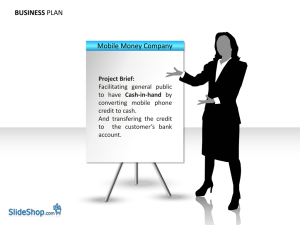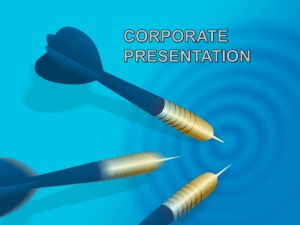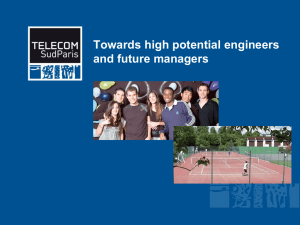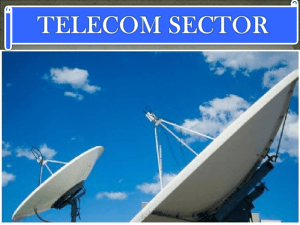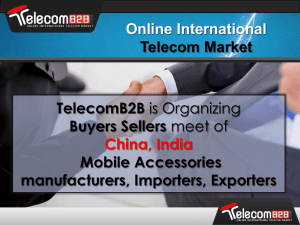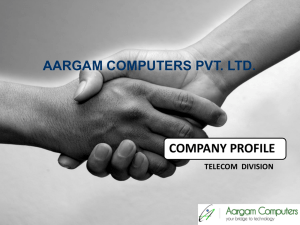Green Passport Report Final
advertisement
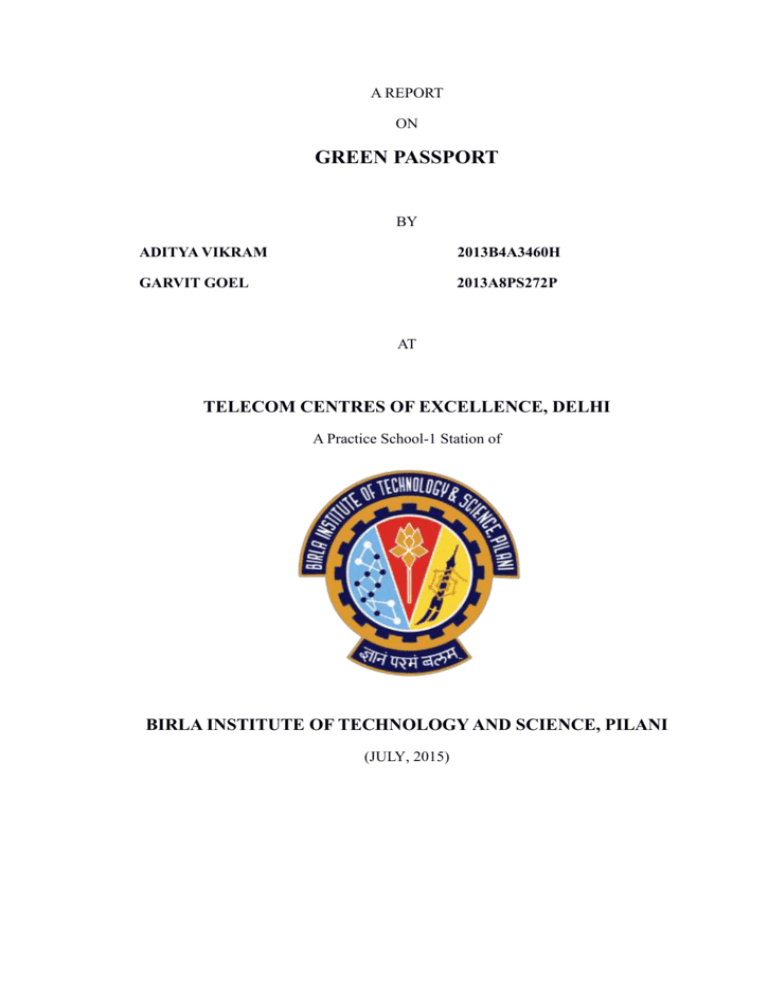
A REPORT ON GREEN PASSPORT BY ADITYA VIKRAM 2013B4A3460H GARVIT GOEL 2013A8PS272P AT TELECOM CENTRES OF EXCELLENCE, DELHI A Practice School-1 Station of BIRLA INSTITUTE OF TECHNOLOGY AND SCIENCE, PILANI (JULY, 2015) A REPORT ON GREEN PASSPORT BY ADITYA VIKRAM 2013B4A3460H EEE+MATHS GARVIT GOEL 2013A8PS272P ENI Prepared in partial fulfilment of the Practice School-I Course No. BITS F221 AT TELECOM CENTRES OF EXCELLENCE, DELHI A Practice School-1 STATION OF BIRLA INSTITUTE OF TECHNOLOGY AND SCIENCE, PILANI (JUNE, 2015) 2 BIRLA INSTITUTE OF TECHNOLOGY AND SCIENCE PILANI (RAJASTHAN) Practice School Division Station: Telecom Centres of Excellence, Delhi Centre: New Delhi Duration: From 22Nd May To 16th July Date of Submission: 15TH July Title of the Project: Green Passport 2013B4A3460H Aditya Vikram EEE+MATHS 2013A8PS272P Garvit Goel ENI Mr. R.K. Pathak Director, Telecom Centres of Excellence Commander Anurag Vibhuti Deputy Director,Telecom Centres of Excellence Neeti Bhatia Manager,Telecom Centres of Excellence Name of PS Faculty : Dr.Trilok Mathur Key Words: Emission,telecommunication,,energy,telecom,cellphones,telecom towers,radiation,standards,access networks,wireless,power,packets,modulation Project Area: Recommendations for Creation of a standards body to rate telecom equipment in India Abstract: The title of our project is Green Passport. Its purpose is to create a framework for establishment of a standards body in India which can rate telecom equipment used in India by taking into consideration various parameters ranging efficiency to emission Signature of Student Signature of PS Faculty Date: 3 Acknowledgement We would like to show our greatest appreciation to Cdr.Anurag Vibhuti, Deputy Director of TCOE for his valuable guidance throughout the project. We would also like to acknowledge the crucial role of Mr.Siddharth Arora for his continuous guidance throughout the project. We are thankful to Mrs. Neeti Bhatia, our co-ordinator for the PS-1 programme. We would like to express our deep gratitude to Ms. Bindu who helped us complete the project. We are also thankful to Dr. Trilok Mathur, our PS-1 instructor for his continuous guidance and encouragement throughout Practice School-1. 4 Table of contents i. Cover………………………………………………………………………………..1 ii. Title Page …………………………………………………………………….…….2 iii. Abstract Sheet ……………………………………………………………….…....3 iv. Acknowledgements………………………………………………………….…….4 A. Orientation at TCOE……………………………………………………….…….6 A.1. Overview…………..…………………………………………………………….6 A.1.1.Success Stories…………………………………………………………7 A.2. Lectures…………...……………………………………………………………..7 A.2.1. Introduction to LTE…………..………………………………………7 A.2.2. Introduction to Optical Communication……..……………………..9 A.2.3. Smart Cities………………………………………………………….10 A.3. Visits…………………………………………………………………………….10 A.3.1. FICCI Visit…………………………………………………………..10 A.3.2. IAN Visit……………………………………………………………..11 B. GREEN PASSPORT………………………………………..……………………12 B.1. Introduction………………………………………………...…………………..12 B.2. Network Architecture……………………………………...…………………..12 B.2.1. Access Network Architecture………………….…………………..13 B.2.2. Customer Premises Equipment……………….…………………..14 B.2.3. Core Network Architecture…………………….………………….15 B.3. Power Consumption………………………………………...…………………16 B.3.1. Fixed Line Access Architecture……………………………………16 B.3.2. Wireless Access Network…………………………………………..16 B.3.3. Customer Premises Equipment………………….………………..17 B.3.4. Core Network Architecture………………………….…………….17 B.4. Carbon Footprint in the telecom industry…………………...………………18 B.5. Energy efficiency metric…………………………………………….18 B.5.1. ITU-T Standard for Telecom Equipment………………………...19 B.5.2. ETSI Standards for Telecom Equipment………………………..20 B.5.3.Economic Impact of the Carbon footprint in the Telecom Industry…………….......................................................................................25 B.6.Conclusions and Recommendations…………………………………………..26 B.7. List of Figures…………………………………………………...……………..28 B.8. List of Abbreviations……………………………………………..…………....29 B.9. Bibliography………………………………………………………..…………..30 5 A.1.OVERVIEW TCOE India is registered as a society under Societies Registration Act XXI of 1860. The need, objective and missions of this organization are as followsNeed: To build a robust ecosystem for R&D, IPR, Standardization and Product development. Objective: Application based R&D and innovation jointly with the industry and academia. Mission: Create synergy amongst academia, telecom industry and the government for creation of new services, generation of IPR, development of manufacturing capability, global telecom standardization activities and promotion of entrepreneurship. There are a total of 8 Telecom Centres of Excellence which conduct research on the various projects allotted to them. Functioning and Organizational Structure TCOEs have adopted the following the following two tier organizational structure. 6 Governing Board for strategic decision making under the Chairmanship of Secretary, Department of Telecommunication (DoT). Current Chairman - Mr Rakesh Garg, Department of Telecommunications, Ministry of Communications & IT, Government of India A Coordination Centre (TCOE CC) headquartered in C-DOT Campus to coordinate amongst all stakeholders and undertake the common activities for all TCOEs, Govt. and Industry. Other than these bodies there are two more committees for looking into the processes carried out by the TCOEs. Executive Council for managing day-to-day activities under the Chairman of Joint Secretary, DoT Current Chairman - Mr V Umashankar, Joint Secretary,DoT,TCOE India A central Steering Committee to administer the research project management, evaluate and identify TCOE for assigning research projects. A.1.1 Success stories As on 31st January, 2015, 41 research papers in aid of policy/management decisions have been published in TCOE and IIMA website. TCOE has successfully contributed in the incubation of 4 startups. TCOE has 89 ongoing projects under telecom sector, out of which 5 technologies have been commercialized in operator network, which include Digital Kisan mandi and Variable phase power plant for access network. Variable phase power plant is a technology developed by BITCOE-IIT Kanpur .This innovation increases the overall long-term running cost efficiency of power plants, in telecom exchanges situated in rural areas. A conventional telecom power plant designed for a three-phase grid input stops working unless all the three phases of the grid are active. This creates operational issues in rural exchanges where grid supply is unreliable and intermittent in nature. To solve this problem, variable phase power plant have been developed that can work with one, two or three phase power input depending on the availability. Digital Mandi Application for Indian Kisan is a unique web and cell phone based application developed by BITCOE (BSNL IIT-Kanpur Centre of Excellence) at IIT-Kanpur which provides a registered farmer alerts through SMS and/or voice on his mobile about selected mandi rates of selected crops. The query and retrieval can be done via internet or on any GPRS enabled cell phone. A.2.LECTURES A.2.1 Introduction to LTE-A On 4th June, 2015, we had our first lecture on LTE-A. The lecture was taken by Mrs. Shivani Sharma and Mr. Anukul Gupta. The main objective of the lecture was to acquaint us with the working of wireless network and emerging technologies, namely HSPA+ and LTE-A. 7 Network Architecture Figure A.1. As seen from the above diagram, a telecom network can be broken down into three network architecture- User equipment (e.g. mobile stations, Wi-Fi dongle etc.), Access network, Core network. Access network is the part of communication network that connects subscriber to the nearest service provider. For 2G network, access network consists of BTSs and RNCs. For 3G and 4G network, BTS and RNC were combined to form NodeB and eNodeB respectively. Core network is the part of telecom network that connects several access networks in different cities. Core network consist of a number of core nodes that are connected through wavelength-division-multiplexed (WDM) optical fiber network. LTE LTE- Long Term Evolution refers to the standard for wireless communication of high speed internet for mobile phones and data terminals. It deploys EDGE and HSPA network technologies, increasing the capacity and speed using different radio interface together with improved core network technologies. Following gives features and benefits of LTE-A Downlink peak rate: 3Gbps Uplink peak rate: 1.5Gbps 8 RAN round trip time < 10ms Increased number of simultaneous active subscribers Supports FDD and TDD Backward compatibility with GSM/UMTS systems C-DOT contribution to LTE technology C-DOT is developing EPC core, the E-UTRAN and UE dongles. C-DOT is developing HSS for LTE-A. C-DOT will support policy control and charging. C-DOT LTE-A will support video, voice and data services through IMS and will provide direct IP connectivity. In order to test the protocol related behavior of EPC core network protocols, C-DOT is using the LTE-A conformance tester. A.2.2. Introduction to Optical Communication Second lecture on optical network was taken by Mr. Gupteshwar Majhi form C-DOT. The lecture included advantages of optical network over copper network, AON and PON, and emerging technologies in core network. Advantages of using Optical Network Fiber provides more bandwidth than copper and has standardized performance up to 10 Gbps and beyond. Fiber provides more bandwidth than copper and has standardized performance up to 10 Gbps and beyond. Data from optical network is extremely difficult to tap and thus more secure. Multiple user can benefit from single optical fiber using GPON technology, thus is cost effective. AON vs. PON Figure A.2. As indicated in the above diagram, AON uses a router that sends only required data at each ONT. PON, on the other hand, takes data from OLT and uses a splitter to splits the entire data to be accessed by ONT. ONT then decides which data is to be sent to the end user. Depending on the topology of the users and the Tele-density in an area, 9 AON and PON can be used separately or a combination of both can also be used. C-DOT contribution to PON technology C-DOT is developing OLTs at Delhi, which can provide connectivity via 96 fiber links. Each link can be connected to 126 users. C-DOT is configuring and testing OLTs for various network topologies C-DOT is developing DWDM (Dense wavelength division multiplex) technology for PON. A.2.3. Smart Cities On 12 June, 2015, we had a lecture on Smart Cities and Need for Standardization by Mrs. Bindu who is currently working at Telecommunications Standards Development Society, India(TSDSI). She opened the discussion by asking what a Smart City meant to us. She then added on to our points and exposed us to the new futuristic technologies that are coming in which will help in making our cities “smart”. One such technology was the Zigbee which provides remote access to the user and helps in wireless communication. Another energy-friendly technology was Smart Street Lights wherein the street lights would remain switched off when no vehicle was around and would switch on automatically whenever a vehicle would pass by. Also Smart Traffic Lights would adjust their duration of red and green lights according to the traffic present on that particular road. Also, there were technologies like Geographical Information System(GIS), Remote Automated Meter Reading(RAMR) and Advanced Metering Infrastructure(AMI). This was a very interesting and informative session as we got an idea as to what our future home would be like. A.3 VISITS A.3.1 FICCI Visit On June 10th, 2015, we went to FICCI (Federation of Indian Chambers of Commerce and Industry) located in Federation House, Tansen Marg, New Delhi. We were given a presentation regarding what FICCI is, what it does and how it goes about doing all this, by Mrs. Ritika – an employee of FICCI. The main focus of the presentation was on the programmes run by FICCI: 1. DST-Lockheed Martin India Innovation Programme Joint initiative by the Department of Science and Technology (India), Lockheed Martin Corporation, Indo-US Science & Technology Forum, IC2 Institute at the University of Texas, Stanford Graduate School of Business and FICCI. It aims at promoting Indian innovative technologies into the global markets. 2. DRDO–FICCI Accelerated Technology Assessment and Commercialization (ATAC) Programme This programme jointly under the Defense and FICCI aims at promoting the DRDO technologies for production of goods and services for the Indian population, examples being, Bio-toilets and explosives detector kit. 3. Millennium Alliance 10 It aims at supporting innovations that exhibit the potential to be scaled broadly and maximize their impact globally. 4. C.V. Raman International Fellowship for African Researchers Department of Science and Technology and Ministry of External Affairs, Government of India and FICCI together have launched this programme to provide opportunity to African researchers to for conducting research under the guidance of Indian scientists in order to advance their own research while contributing to the progress of research in India. A.3.2 IAN visit We visited the Indian Angel Network in New Delhi on 13th June,2015. We had a lecture by Mr.Bikky Khosla on the topic “Investor and Field Experts Guide to Manage and Build a Thriving Business Online”. His background tells us how from the late eighties, he has been finding new ways to make the Indian export-import sector, which comprises mostly Small and Medium Enterprises (SMEs), more competitive in the global scenario. During his stint as an exporter, Mr. Khosla realized that there was a huge latent demand from the trading community — a demand for easier and faster accessibility of various international trade related information like the database of buyers, sellers, price quotations, etc. With this lofty vision, Bikky Khosla conceptualized Infocom Network Ltd. in 1991 and released India's first ever directory on Indian manufacturers and exporters 'Exporters Yellow Pages.' This was closely followed by the launch of India's first B2B portal – Tradeindia (www.tradeindia.com). Soon Mr. Khosla's strategy paid off with tradeindia.com today being one of the most successful Internet business entities in the country today, contributing over USD 3 billion to India's annual e-commerce. In the talk he discussed the various challenges and opportunities that an entrepreneur has to encounter on the way to building a successful business and generating value. We discussed how all successful companies like Google, Amazon, Flipkart have been built. He also talked about the values that an entrepreneur should ideally possess. He also discussed the various factors that form the core of ecommerce business. They are listed as follows: Front-End and Backend Systems Laterally 1. Between a company and its customers 2. Business partners, suppliers or intermediaries Horizontally: 1. Enterprise resource planning (ERP) 2. Customer relationship Management (CRM) 3. Knowledge Management Supply-chain managements systems downward through the enterprise, for integration of new technologies with radically redesigned business processes The majority of the audience in the programme were themselves entrepreneurs and picked Mr.Khosla’s brain picking up valuable knowledge pertaining to their respective businesses. 11 GREEN PASSPORT B.1. INTRODUCTION In the last decade the attention on environment friendly solutions has drastically increased. Especially, due to the debate concerning the climate change, every technology is evaluated on carbon footprints and energy efficiency. Same is the case with Information and Communication Technologies (ICT). It is estimated that ICT is accountable for 2–4 percent of worldwide carbon emissions. By 2020 these emissions are expected to double if no initiatives are taken to reduce this footprint. A significant part of these emissions, about one sixth, is attributed to telecommunication networks. In India, according to the Telecom Regulatory Authority of India (TRAI), wireless subscribers have increased from 391.76 million to 584.32 million from FY 2008–2009 to FY 2009–2010 – an annual growth rate of about 49.15%. Mobile phone demand in India has increased and the compound annual growth rate (CAGR) is 62.09% between FY 2005–2006 and in FY 2010–2011. Tele-density, which is the number of wireless connections per 100 people, has increased from 12.86% to 57.29% during the same period. The increase in the number of subscribers has led to greater energy consumption. Between FY 2005–06 and FY 2010–11, the energy consumed by the mobile telecom sector increased from 39 PJ (petajoule) to 163 PJ – an annual growth rate of 63%. The CO2 emissions increased from 10.11 to 52.66 million tons during the same period. Figure B.1. Projected growth of mobile subscribers Consequently, emerging technologies in telecommunication sector need to be evaluated on their environmental impact. Telecom equipment needs to be standardized on the basis of energy consumption and their impact on environment which will help to compare the results of one telecom operator with other operators to find any energy efficiency improvement need to be made. Following report discusses on various algorithms used to develop standardization of telecom 12 equipment succeeded by the brief description on existing standards. B.2.NETWORK ARCHITECTURE Following figure gives an overview of the different types of network architecture we will consider. Figure B.2. Network overview B.2.1 Access Network Architecture An Access network is a part of communication network that connect subscriber to the immediate service provider. The purpose of access networks is to provide a connection to users through which they access the Internet. They are usually organized in tree structures. All users are connected to a central office in which the traffic is aggregated and transferred to a core network. Depending on the used technologies, the tree has different aggregation levels at intermediary nodes. Fixed Line Network In this network, user physically connects to the network through a wire. Three main types of technologies are currently used. Digital Subscriber Line (DSL) which uses the twisted pair copper cables from the old telephone lines. Several technology flavors exist, varying in bit rate and maximum range. Asymmetric DSL (ADSL) and very high bit rate DSL (VDSL) flavors are best known. A second technology is coax cable technology on which the Data Over Cable Service Interface Specification (DOCSIS) standard is used. These networks are typically built starting from legacy television broadcasting networks. 13 Presently, optical technologies are emerging. These technologies are already used deeper in the network where higher bit rates are required. At present, optical technologies are starting to appear at the user edge of the network. They are built with either a dedicated connection to the user (point-to-point), an intermediary active splitter (active star), or intermediary passive splitters (passive optical network, PON). Optical access networks can be terminated with a VDSL node with limited range and are called fiber to the building (FTTB), fiber to the cabinet (FTTC), or, more generally, fiber to the x (FTTx). However, FTTx also includes fiber to the home (FTTH), which denotes full optical access networks. Wireless Access Network In this network, the user connection is provided through a wireless link. The user’s devices use radio signals to connect to a base station. Different technologies are available varying in transmission power, transmission frequency, modulation scheme and multiplexing technique and thus providing different access bit rates to the users. The three main emerging wireless technologies are mobile Worldwide Interoperability for Microwave Access (WiMAX), high-speed packet access (HSPA), and Long Term Evolution (LTE). Mobile WiMAX is based on the IEEE 802.16 standard. It operates in the 2–6 GHz band, and is developed for mobile wireless applications and allows people to communicate while they are moving. The highest supported bit rate is approximately 70 Mb/s. HSPA is the successor of the widely deployed universal mobile telecommunications system (UMTS), also known as third generation [3G]). HSPA provides increased performance by using improved modulation schemes and refining the protocols by which handsets and base stations communicate. The end-user experience is further improved by increasing the peak data rates up to14 Mb/s in the downlink. HSPA uses the 2.1GHz band. LTE is the newest wireless broadband technology. LTE is marketed as the fourth generation (4G) of radio technologies. Targets for the bit rate are to have peak data rates from 10 Mb/s up to 300 Mb/s in the downlink. However, in practical implementations 300 Mb/s rates have not yet been achieved. LTE uses the 2.6 GHz band. B.2.2. Customer Premises Equipment At the customer premises the access networks connect to customer premises equipment. For fixed line networks this is usually a home gateway (modem), which then further connects to other equipment such as a notebook or set-top box. For wireless network, it can be a mobile phone, wireless network interface card in a 14 computer, or a home gateway. B.2.3. Core Network Architecture Access networks aggregate the users in a certain area. In order to interconnect these areas, core network are used. A core network consists of a number of core nodes that are interconnected through wavelength-division multiplexed (WDM) optical fiber links, usually in a mesh or ring topology. Core nodes are optical- electrical-optical-based. This means that all optical traffic is converted to the electronic domain and processed by the node, whether the traffic is terminated at this node or not. In general, a node consists of a number of WDM transmit and receive cards, also referred to as transponders or transceivers, which are connected to an IP router. The IP router in turn can be connected to a number of access routers. WDM fiber links carry a number of wavelengths, each typically having a capacity of 10 or 40 Gb/s. 40 to 80 wavelengths/fiber are common. Optical amplifiers are necessary at intervals of about 80 km to make up for signal attenuation. Current core networks are typically a mix of several layers of technologies on top of each other, such as IP-over-ATM-over-SDH (Internet Protocol, asynchronous transfer mode, synchronous digital hierarchy), as illustrated in following figure. However, there is a trend to move to more homogenous architectures where IP is routed directly over WDM links. Figure B.3. Core network node architecture. 15 B.3. POWER CONSUMPTION Figure B.4. Power consumption and Carbon emission from telecommunication network. As seen from the above figure, approximately 90% of the energy consumption is concentrated in access network i.e. Radio stations and Network control. In this section we will quantify the energy consumption of individual network. B.3.1. Fixed Line Access Network In fixed line access networks each subscriber (Subs) has a dedicated connection. Thus, the power per subscriber is a stable metric. ADSL equipment consumes 1–2 W/Subs, VDSL equipment roughly consumes 3–5 W/Subs. Optical network equipment currently consumes 10–20 W/port. However, using GPON technology, this can be further distributed. The OLT consumes 0.2–0.8 W/Subs. B.3.2. Wireless Access Network In wireless access networks, the highest power consumer is the base station. The power per subscriber is largely dependent on the subscriber density in the area covered by the base station. Therefore, power consumed per base station is first evaluated and then translated to power consumed per user. A base station is here defined as the equipment needed to communicate with the mobile stations and the backhaul network, for example BTS and RNC in case of 2G network. Mobile WiMAX has the lowest power consumption of approximately 2.9 kW/base station, and a range of 340 m. LTE has the highest power consumption, 3.7 kW/base station, and the largest range, of approximately 470 m. HSPA has the lowest range, 240 m, of all the considered technologies and a power consumption of 3.7 kW/base station, which is comparable to the power consumption of LTE. If we consider the tele-density to be 300/km2, we see that LTE performs the best with a power consumption of 18 W/Subs, followed by Mobile WiMAX with a power consumption of 27 W/Subs. HSPA has the highest power consumption per user, 68 16 W/Subs, caused by its lower range. B.3.3. Customer Premises Equipment At present, for fixed line technologies, the home gateway (e.g. a DSL modem) consumes 5–10 W, which is higher than the power consumption in the access network. Home gateways for optical networks also tend to have higher energy consumption than their DSL counterparts. In wireless networks the power consumption of the mobile stations is much lower since these are designed for mobile applications, which require low power consumption for longer time B.3.4. Core Network The purpose of core networks is to transfer traffic streams between different sites. Thus, power consumption in the core network is typically expressed in Watts per transferred bit. Figure B.5. Power consumption of a set of mid-tier and high-end routers The above figure illustrates the power consumption of number of model routers against their aggregated capacity. As can be seen, high-end routers (routers with higher capacity) are more energy-efficient than low-end routers, while consuming more in absolute values, the power required to transfer a bit decreases with increasing router capacity. Current routers consume between 0.1 and 0.01 W/Mb/s. 17 Figure B.6. Summary of power consumption per subscriber of different network technologies B.4. The Carbon footprints in the telecom industry The carbon footprint from any telecom equipment can be evaluated using the following formula: CM = 0.365 [0.84 xM PM + (0.528 yM zM / η)] in Tonnes Where CM is the carbon emission in Tonnes from a unit M, PM is the power consumption of M in kW, xM is the number of hours for which grid power is available, yM is the number of hours for which power is available from a DG (Distributed Generation) at zM kW, η is the efficiency of generator. For example, if the consumption of power for Core Network, in KW, (including Air Conditioning etc.) is Pc, the Grid power is for ‘xc’ hours, the power from ‘zc’ KVA DG is for ‘yc’ hours and the efficiency of the generator is ‘η’ then CC = 0.365 [0.84xc Pc + (0.528 yc zc / η)] in Tonnes Carbon footprint from access network (CA) and customer premises equipment (CE) can be similarly calculated and summed to evaluate the total carbon emission from telecom network. CT = CA + CC+ CE 18 B.5. Energy efficiency metric A metrics is a number to evaluate the energy efficiency of an equipment based on the ratio: useful work/energy consumption. The energy efficiency metric is typically defined as the ratio between the functional unit and the energy necessary to deliver the functional unit. The higher the value of the metric, the greater the Efficiency of the equipment. The inverse metric, energy divided by functional unit, could also be used as an alternative. B.5.1. ITU-T standard for Telecom Equipment Metric for DSLAM, MSAM GPON GEPON equipment For these equipment typologies, the most commonly used metric is the Pport, which considers the number of ports at a fixed load as a functional unit. Pport= PEQ /Nports [W/port] where, PEQ is the power (in watts) of a fully equipped wire-line network equipment, and Nports is the maximum number of ports served by the broadband network equipment under test. PEQ = (power at 100% load + power at 50% load + power at 0% load) / 3 Metrics for wireless access technologies A wireless access network consists of more than one element, a radio base station (RBS), a controller, etc. RBS can be a base transceiver station (BTS) (for GSM/EDGE and cdma2000), a NodeB (for WCDMA/ high speed packet access (HSPA)), an eNodeB (for LTE) or a base station (for WiMAX). The average power consumption [W] of integrated RBS equipment in static method is defined as: Pequipment = (PBH.tBH + Pmed.tmed + Plow.tlow) / (tBH+ tmed + tlow) where, PBH is the power consumption [W] with busy hour load. Pmed is the power consumption [W] with medium term load. Plow is the power consumption [W] with low load. The network level energy efficiency is defined as the following: EEcoverage = Acoverage/ Psite where, Acoverage is the RBS coverage area [km2] Metrics for routers and Ethernet switches The metrics adopted for routers and switches depend on the total throughput of the equipment. The proposed metric is: EER= Ti/Pw [Mbit/s/W] where, Ti is weighted throughput, Pw is weighted power 19 Ti = a.Tu1 + b.Tu2 + c.Tu3 Pw = a.Pu1+b.Pu2+c.Pu3 where: (a, b, c) = relative weights for utilization levels, where a + b + c = 1 (Pu1, Pu2, Pu3) = power measured at respective utilization levels (Tu1, Tu2, Tu3) = throughput measured at respective utilization levels Metrics for small networking devices The metrics adopted for small networking devices intended for home/domestic or small office use is: EER= (.35.Tidle + .5.Tlowpower + .15.Tmaximum) / (.35.Pidle + .5.Plowpower + .15.Pmaximum) (Mbit/s/W) For interfaces with throughput (T) sensitive to distance, this is defined as: T = 0.5(T 20% of max distance +T 80% of max distance) B.5.2. ETSI standards for Telecom equipment Metric for wireless access network The average power consumption [W] of integrated RBS equipment in static method is defined as: Pequipment = (PBH.tBH + Pmed.tmed + Plow.tlow) / (tBH+ tmed + tlow) Psite = PSF. CF. Pequipment , where PSF is power supply correction factor [unit less] and CF is cooling factor [unit less] Power supply factor and cooling factor varies as follows: PSF, Power Supply Factor depending on power supply: - Equipment with AC power interface: PSF = 1.0 - Equipment with DC power interface: PSF = 1.1 CF, Cooling factor, depending on type of cooling solution for outdoor conditions: - Indoor RBS equipment with fresh air fan based cooling solution: CF = 1.05 - Indoor RBS equipment with air condition controlled to 25 °C: CF = 1.5 - Outdoor RBS equipment: CF=1.0 Network level energy efficiency for GSM The network level energy efficiency for rural area is defined as the following EEcoverage = Acoverage / Psite Acoverage is the RBS coverage area [km2] For urban area, the dominant factor for the dimensioning of a network is the capacity of RBS. Thus the network level performance indicator (subscribers/W) for urban case is defined as: EEcapacity = Nbusy_hour / Psite , where Nbusy_hour is the number of subscriber connected to RBS at a busy hour. Network level energy efficiency for WCDMA/LTE/WiMax To calculate the energy efficiency of data services, the power consumption of the RBS 20 is sampled continuously (interval time Δtm: 0.5 seconds or shorter) over the complete period TD of the test and summed to get the energy consumed by the RBS using the following formula: The average net data volume DV ALx during one test cycle period is determined by the following formula: The efficiency indicator for the network is than calculated as: EEequipment = Eequipment / DV Metrics for core network The power consumption is defined for three different load levels, defined as following: High: TH = 1.0 × TS Mid: TM = 0.7 × TS Low : TL = 0.1 × TS , where TS is the maximum capacity according to vendor’s specifications. The power consumption levels associated with the above load levels are defined as: High: PH = average power consumption [W] measured at TH Mid: PM = average power consumption [W] measured at TM Low: PL = average power consumption [W] measured at TL The average power consumption is defined as: Pavg = α × PL + β × PM + γ × PH [W] , where α, β, and γ are weight coefficients selected such as (α + β + γ) = 1. The network load can be distinguished into three categories: Voice Data Subscriber 21 The weight coefficients for the normalized traffic profiles are given in following tables: Profiles Voice Data Subscriber KPI (Key Performance indicator) Erlang or subscriber PPS or SAU Subscriber Pavg weight coefficients α β γ 0.4 0.2 0.1 0.4 0.35 0.4 0.2 0.45 0.5 The Energy Efficiency Ratio metric, the comparable performance indicator, for Core networks is defined as: EER = Useful Output / Pavg [Erlang/W | PPS/W | Subscribers/W | SAU/W] ,where Useful Output is the maximum capacity of the system under test (TS) which, depending on the different functions, is expressed as the number of Erlang (Erl), Packets/s (PPS), Subscribers (Sub), or Simultaneously Attached Users (SAU). Erlangs represents the average number of concurrent calls carried by the circuits (or other service-providing elements), where that average is calculated over some reasonable period of time. Indian Scenario In the current scenario, biggest problem the telecom industry in India is facing is the unavailability of Electricity from the grid. Today, on average, 70 percent of the approximately 400,000 mobile towers in India face electrical grid outages in excess of 8 hours a day. 22 FIGURE B.7. Average per day grid availability by region in India The graph given above plots the number of hours for which electricity is available from grid versus the respective state in India. The horizontal line shows the weighted average for the y- variable which is less than 19 hours per day. Furthermore, the plot also shows that 7 states receive grid power for less than 14 hours a day. Hence, there is a need for the telecom operators to use alternative source to provide electricity for their equipment like diesel generators, batteries etc. to address the demand-supply gap. Since the efficiency of these alternative sources is much less than grid energy, there is a consequent need to reevaluate the telecom equipment on the basis of their power efficiency. Power consumption for these equipment will be calculated using the following formula. Pequipment = (Prated * xgrid + (Prated *yDG) / η) / 24 , where Prated is the rated power consumption of equipment, xgrid is the number of hours for which electricity is available from the grid, ygrid is the number of hours for which electricity is available from DG η is defined as the ratio of efficiency of electricity generation from grid to the efficiency of electricity generation from Diesel Generator. = ηgrid / ηDG 23 Metrics for Indian scenario Access network Fixed line network Fixed line access network uses two techniques for communication- circuit switching (for voice data) and packet switching (for video and other data services like internet). Standardization for network using circuit switching will be done using the following metrics: Eequipment = Nports / PEQ , where Nports is the maximum number of subscriber that can be connected to the network PEQ is the power consumption at that load modified using the formula described in section B For equipment using the packet switching technique (GPON, DOCSIS etc.), the metric for energy efficiency will remain same as given above but the definition of Nports will differ. For such equipment Nport will be defined as the maximum number of customer premises equipment that can be connected to the network such that the data flow rate for each user stays above a certain specified value. Wireless access network The number of user equipment connected to a wireless network can vary over time. Therefore, the energy efficiency of wireless access network is defined as the maximum area Acoverage covered by a single equipment divided by the modified power consumed PEQ. Eequipment = Acoverage / PEQ , where PEQ= (PBH.tBH + Pmed.tmed + Plow.tlow) / (tBH+ tmed + tlow) Acoverage will be defined as the area covered by the cell site in an open field so that the signal strength stays above -100db (minimum threshold for GSM). Signal strength (in db) Signal quality Above -65 Excellent -79 to -65 Good -89 to -80 OK/shouldn't have problems -99 to -90 Getting bad/signal may break up -105 to -100 Bad/drop call Core network In core network, equipment are standardized using the metric defined as the ratio of throughput (Ti) of the equipment under inspection and the power consumed at a particular load. (Note: power here refers to the modified power consumed calculated using the formula given in section B) 24 EER= Ti/Pavg Throughput here is defined individually for various types of loads. For circuit switched load, throughput is defined in terms of erlangs. For packet switched load, throughput is the maximum data rate that the equipment can handle. Average Power consumption will be calculated using the weighted mean of power consumed a various load levels. Weights in the equation will be defined for each type of load separately. B.5.3. Economic Impact of the Carbon footprint from Telecom industry The carbon emission from a telecom equipment can be calculated using the formula given in section B.4. CM = 0.365 [0.84 xM PM + (0.528 yM zM / η)] in Tonnes Since the power consumption and carbon emission in telecom sector is concentrated in access network, we will calculate the carbon footprint from fixed line access network as well as wireless access network. Assumption here is that the grid power is available for 19 hours in one day and the DG is used for rest of the day which is working at an efficiency of 60%. The Kva rating of the DG is assumed to be 10Kva Fixed line access network No. of broadband subscribers: 60 million Average power consumed by each subscriber (including ADSL, VDSL, GPON): 2W Using the above formula, the carbon emission for a single subscriber is 0.015 tonne. Total carbon emission: 900000 tonnes. Wireless access network Number of cell sites (including BTS, BSC, RNC, eNodeB, NodeB) in India: 736654 Average power consumed by each mobile tower: 3.5Kw The carbon emission calculated for a single mobile tower: 36.4 tonne Total carbon emission due to wireless access network: 27000000 tonnes The telecom tower industry in India is estimated to consume over 2.5 billion litres of diesel annually making it the second largest consumer of diesel in the country. This business continuity service results in a revenue loss of INR 14.64 per litre of 25pprox.25g to approximately INR 3,660 Crore (USD 732 million 25pprox.) annually. The 2.5 billion litres of diesel consumed, emit 6.6 million metric tons of CO2 annually, making the current use of diesel generators both an environmentally and economically unattractive solution. 25 B.6. CONCLUSIONS AND RECOMMENDATIONS India has made a very good beginning towards achieving the Green Telecom objectives . Current regulatory definitions need refinements in terms of estimating the accurate Carbon emission from Telecom Network Equipments and setting up the reasonable and realistic targets of reduction in carbon emission. The green telecom goal setting and the obligatory compliance will require necessary policy reforms that must be based on the sound study outcome carried out by Indian standardization organization with active participation from Telecom Service Providers, Telecom equipment providers, Technology Research & Development Organization and Government. Some of the key Standardization and Policy formulation objectives are: Evolution and adoption of the accurate carbon emission measurement estimation suitable for Indian telecom network. Setup a national framework of information that contains the entire information related to carbon emission estimation from all the telecom service providers and Infrastructure providers. The common framework must be utilized for consolidating nationwide carbon emission estimates and study the necessary trend. This framework must relieve TSP to provide large reports as prescribed today. Regulator should also be able draw necessary interpretation with regard to the verification of carbon emission data, estimation reports to check regulatory compliances and setting up the realistic and reasonable future goals. Establishing a system for automatic information collection from the source of the information by building necessary technical mechanisms utilizing the recent advances in technology and their technical standards. The source of the information in this case is Infrastructure provider (IP) for providing SwitchOn/Off timing for various types of power sources and the consumed power . The source also includes inbuilt capability of each telecom equipment to assess and report the dynamic power consumption based on experienced traffic. Adequate and immediate focus on achieving energy efficiency in the telecom network by following necessary Standards for measurements and metrics of energy efficiency, development of energy efficient technology building blocks, telecom products based on such building blocks and their adoption in the network under a national framework. Access power generation at the Base station sites is one major cause for escalated estimation of Carbon Emission in Indian Telecom Service provisioning that should be treated as separate problem to address. There should be a nationwide consolidation of the unutilized access power generated by IP for meeting the TSP requirement and a suitable policy should be formed for its utilization. In order to provide adequate focus on the overall carbon emission reduction exercise, it would be necessary to set separate target of the carbon emission reduction for all the network segments separately 26 The systems for automatic gathering the parameters required for estimating carbon emission would also be required to achieve the full objective of such a comprehensive solution for carbon emission estimation and reduction for establishing global leadership in this field. One of significant standardization delivery from GISFI’s Technical Working Group on “Internet of Things (IoT)” as Application domain independent Generic Framework of IoT Based solutions is very appropriate candidate to be adopted for developing such system for Telecom Carbon Emission in India. All telecom products, equipments and services in the telecom network should be Energy and performance assessed and certified “Green Passport [GP]” utilising the ECR’s Rating and the Energy ‘passport’ determined by the year 2015. All Service providers should evolve a ‘Carbon Credit Policy’ in line with carbon credits norms with the ultimate objective of attaining full carbon neutral footprints in rural areas and with 50% carbon neutral footprint in urban areas by the year 2020. The base year for calculating all existing carbon footprints would be 2011, with an 100 implementation period of one year. Hence the first year of carbon reduction would be the year 2012. 27 LIST OF FIGURES Figure No. Figure Page no. A.1 Network Architecture 8 A.2 AON VS PON 9 B.1 Projected Growth of Mobile Subscribers in India 12 B.2 Network Overview 13 B.3 Core Network Node Architecture 15 B.4. Power consumption and Carbon emission from telecom networks Power consumption of a set of mid-tier and high-end routers Summary of Power Consumption per subscriber of different network technologies Average per day grid availability by region in India 16 B.5 B.6 B.7 28 17 18 23 LIST OF ABBREVIATIONS S.No. ABBREVIATION MEANING 1 RNC Radio Network Control 2 BTS Base Transceiver Station 3 CDMA 4 LTE 5 HSPA 6 HSS 7 IP 8 ONT Optical Network Terminal 9 OLT Optical Line Terminal 10 ICT Information and Communication Technologies 11 DSL Digital Subscriber Line 12 FTTx Fiber to the x 13 UMTS Universal Mobile Telecommunication Systems 14 WDM Wavelength Division Multiplex 15 SDH Synchronous Digital Hierarchy 16 GPON Gigabit Passive optical Network 17 WiMAX Worldwide Interoperability for Microwave Access 18 MSAM Multiple Services Application Module 19 RBS Radio Based Station 20 ITU International Telecommunication Union 21 TCOE Code Division Multiple Access Long Term Evolution High Speed Packet Access Home Subscriber Server Internet Protocol Telecom Centres of Excellence 29 BIBLIOGRAPHY 1. Energy consumption and CO2 emissions by the Indian mobile telecom industry; S.S. Krishnan*, N. Balasubramanian and A. Murali Ramakrishnan (2012). 2. Power Consumption in Telecommunication Networks: Overview and Reduction Strategies; Willem Vereecken, Ward Van Heddeghem, Margot Deruyck, Bart Puype, Bart Lannoo, Wout Joseph, Didier Colle, Luc Martens, and Piet Demeester, Ghent University (IEEE 2011) 3. TRAI Consultation Paper On Green Telecommunications; (February, 2011) 4. Energy efficiency metrics and measurement methods for telecommunication equipment; ITU-T L.1310 (8/2014) 5. Power consumption of base stations; Alberto CONTE Alcatel-Lucent Bell Labs France 6. Approach towards standardization of Telecom Equipment for Certification of “Green Passport”; Ram Krishna, DDG (FLA), TEC and Mrs. Laxmi, Dir(FLA), TEC 7. GISFI TR GICT.105 V1.1.0 (2012-12): Metrics and Measurement Methods for Energy Efficiency 8. GISFI TS GICT.101 V1.0.0(2013-02) Metrics and Measurement Methods for Energy Efficiency: Classification of Telecommunication Equipments; (Release 1) 9. ETSI TR 102 530 V1.1.1 (2008-06) Environmental Engineering (EE) The reduction of energy consumption in telecommunications equipment and related infrastructure 10.ETSI TR 102 532 V1.1.1 (2008-06) Environmental Engineering (EE) The use of alternative energy solutions in telecommunications installations 11. ATIS-0600015.2009: Energy Efficiency For Telecommunication Equipment: Methodology For Measurement and Reporting - General Requirements (Baseline Document) 30 31 32
